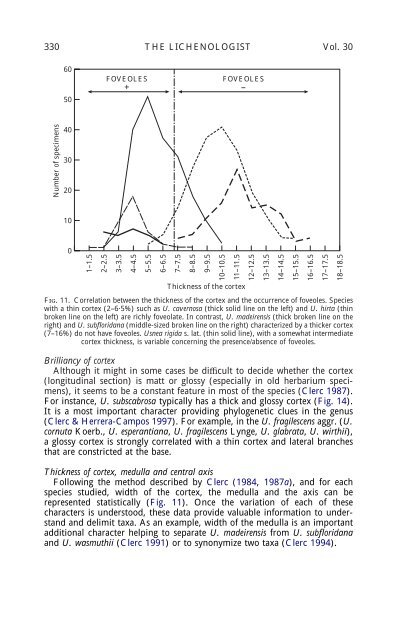SPECIES CONCEPTS IN THE GENUS USNEA (LICHENIZED ...
SPECIES CONCEPTS IN THE GENUS USNEA (LICHENIZED ...
SPECIES CONCEPTS IN THE GENUS USNEA (LICHENIZED ...
Create successful ePaper yourself
Turn your PDF publications into a flip-book with our unique Google optimized e-Paper software.
330 <strong>THE</strong> LICHENOLOGIST Vol. 30<br />
Number of specimens<br />
60<br />
50<br />
40<br />
30<br />
20<br />
10<br />
0<br />
1–1.5<br />
FOVEOLES<br />
2–2.5<br />
3–3.5<br />
4–4.5<br />
+<br />
5–5.5<br />
6–6.5<br />
7–7.5<br />
8–8.5<br />
Thickness of the cortex<br />
Brilliancy of cortex<br />
Although it might in some cases be difficult to decide whether the cortex<br />
(longitudinal section) is matt or glossy (especially in old herbarium specimens),<br />
it seems to be a constant feature in most of the species (Clerc 1987).<br />
For instance, U. subscabrosa typically has a thick and glossy cortex (Fig. 14).<br />
It is a most important character providing phylogenetic clues in the genus<br />
(Clerc & Herrera-Campos 1997). For example, in the U. fragilescens aggr. (U.<br />
cornuta Koerb., U. esperantiana, U. fragilescens Lynge, U. glabrata, U. wirthii),<br />
a glossy cortex is strongly correlated with a thin cortex and lateral branches<br />
that are constricted at the base.<br />
Thickness of cortex, medulla and central axis<br />
Following the method described by Clerc (1984, 1987a), and for each<br />
species studied, width of the cortex, the medulla and the axis can be<br />
represented statistically (Fig. 11). Once the variation of each of these<br />
characters is understood, these data provide valuable information to understand<br />
and delimit taxa. As an example, width of the medulla is an important<br />
additional character helping to separate U. madeirensis from U. subfloridana<br />
and U. wasmuthii (Clerc 1991) or to synonymize two taxa (Clerc 1994).<br />
9–9.5<br />
10–10.5<br />
FOVEOLES<br />
–<br />
Fig. 11. Correlation between the thickness of the cortex and the occurrence of foveoles. Species<br />
with a thin cortex (2–6·5%) such as U. cavernosa (thick solid line on the left) and U. hirta (thin<br />
broken line on the left) are richly foveolate. In contrast, U. madeirensis (thick broken line on the<br />
right) and U. subfloridana (middle-sized broken line on the right) characterized by a thicker cortex<br />
(7–16%) do not have foveoles. Usnea rigida s. lat. (thin solid line), with a somewhat intermediate<br />
cortex thickness, is variable concerning the presence/absence of foveoles.<br />
11–11.5<br />
12–12.5<br />
13–13.5<br />
14–14.5<br />
15–15.5<br />
16–16.5<br />
17–17.5<br />
18–18.5

















